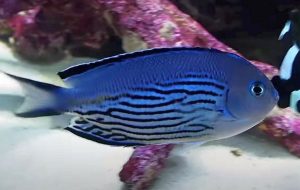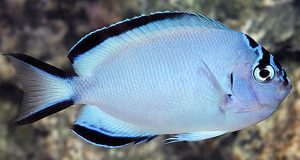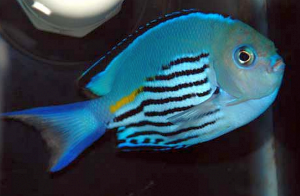The Wantanabe Angel (Genicanthus watanabei) known to tropical fish keeping enthusiasts as Watanabe’s Lyretail Angelfish and Blackedged Angel is found within the waters of the Pitcairn and Society Islands; part of Polynesia in the South Pacific Ocean.
Genicanthus are found from Japan to the Philippines, South to New Caledonia and the Austral islands and Melansia, however, they are most often caught and offered to tropical fish keeping enthusiasts from the Phillipines, the Coral Sea, and rarely from Melanesia.
The Wantanabe Angel is the smallest of the so called “Swallowtail” angels that seldom exceeds six inches in length. As their name implies, Wantanabe Angels have long “swallowtail” like filamentous extensions on both caudal lobes of both sexes.
Males have an iridescent pale blue body color highlighted by eight long, thin, black horizontal stripes starting just behind the gill plate that extend from the mid to lower portion of the body, and one horizontal orange stripe at the rear mid-body that extends toward the tail. The outer edges of the dorsal, anal, and caudal fins are edged in black.
Females also have an iridescent pale blue body color but lack the stripes found in males. They have unique black bars on the head that joins the eyes and a black band along the upper and lower edges of the dorsal, anal, and caudal fins.
A unique trait of Watanabe’s Angelfish and all ten members of the Genicanthus genus of Pomacanthidae, is the prominent sexual dichromatism between the sexes that makes them easy to sex.
Like many marine angelfish species, all Genicanthus angels are protogynous hermaphrodites that begin life as females and have the ability to morph into males. When held in small groups or harems, the dominant female in the group will often transform into a male. The process will usually take anywhere from 20 to 40 days to accomplish.
The Wantanabe Angel is a peaceful species that is tolerant of conspecifics and other angelfish species. In an aquarium environment they should be introduced into the tank first before other angelfish who may not tolerate them.
Wantanabe Angelfish can be housed as singles, pairs, or in small harems of a single male and multiple females, provided the tank is large enough.
Genicanthus watanabei are best housed in a mature deep water reef aquarium of at least 125 gallon capacity with a variety of hard and soft corals and plenty of mature algae covered live rock arranged into caves, overhangs, and crevices for them to graze upon and hide among. They are open water swimmers that require plenty of free swimming space and do best in a dimly lit tank that replicates their deep water habitat.
A chiller is needed to maintain the cool 74° F temperature they prefer. Like other deep water species, Wantanabe Angels require stable water conditions and pristine water quality to thrive. The Wantanabe Angelfish is perfectly reef safe with Soft and Hard Corals (including Stony Corals) not likely to be harmed.
Wantanabe angelfish can be housed with other peaceful, non threatening tank mates such as Snowflake Clownfish, small wrasses, Anthias, gobies, chromis, blennies, Scarlet Cleaner Shrimp, etc.
The Wantanabe angelfish is now being captive bred, however they are pelagic spawners that are very difficult to breed in an aquarium environment.
The Wantanabe angel feeds almost constantly in their natural environment on planktivores, small crustaceans, and algae. In an aquarium environment they are easy to feed once acclimated and will accept almost anything floating in the water column.
In addition to having a large quantity of live rock in the aquarium for them to graze upon, a varied diet rich in Mysis shrimp, marine plankton, vitamin enriched brine shrimp, finely chopped crustaceans, Spirulina, marine algae, and a high quality commercial angelfish preparation fed multiple times daily will keep Genicanthus watanabei in good condition. Frequent small feedings are recommended for this species.
Although the Wantanabe Angel (Genicanthus watanabei) is seldom available to tropical fish keeping enthusiasts, they can be occasionally found in specialty fish shops and ordered online from importers, wholesalers, retailers, and collectors at relatively reasonable prices for deep water species. There are usually waiting lists for this species at purchases sizes from: Small 1 1/4″ to 2-1/2″ Small/Medium: 2-1/2″ to 3″ Medium 3″ to 4″; Medium/Large: 4-1/4″ to 5-1/4″ Large 5-1/4″ to 6 ” at current prices from $150.00 to $350.00.
Minimum Tank Size: 125 gallons
Aquarium Type: Deep water Reef
Care Level: Moderate
Temperament: Peaceful
Aquarium Hardiness: Difficult to acclimate
Water Conditions: 72-78°F, dKH 8 to 12, pH 8.1 – 8.4, sg 1.020-1.025
Max. Size: 6″
Color Form: Orange, Blue, White
Diet: Omnivore
Compatibility: Reef
Origin: Pitcairn and Society Islands
Family: Pomacanthidae
Lifespan: 2-5 years
Aquarist Experience Level: Expert




